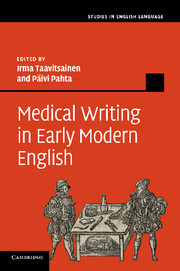Book contents
- Frontmatter
- Contents
- List of plates
- List of figures
- List of tables
- Notes on contributors
- Preface
- List of abbreviations
- 1 An interdisciplinary approach to medical writing in Early Modern English
- 2 Medical texts in 1500–1700 and the corpus of Early Modern English Medical Texts
- 3 Medical literacies and medical culture in early modern England
- 4 Verbs of knowing: discursive practices in early modern vernacular medicine
- 5 Defining in Early Modern English medical texts
- 6 Dissemination and appropriation of medical knowledge: humoral theory in Early Modern English medical writing and lay texts
- 7 Code-switching in Early Modern English medical writing
- 8 New arguments for new audiences: a corpus-based analysis of interpersonal strategies in Early Modern English medical recipes
- 9 Efficacy phrases in Early Modern English medical recipes
- 10 Medical pamphlets: controversy and advertising
- 11 The development of specialized discourse in the Philosophical Transactions
- 12 The expression of stance in early (1665–1712) publications of the Philosophical Transactions and other contemporary medical prose: innovations in a pioneering discourse
- Appendix A Raw data tables corresponding to Figures 4.3–4.14
- Appendix B Raw data tables corresponding to Figures 8.1–8.4
- Appendix C Stance markers used in the analysis in Chapter 12
- Appendix D Preliminary list of texts in the corpus of Early Modern English Medical Texts (EMEMT)
- Bibliography
- Index
8 - New arguments for new audiences: a corpus-based analysis of interpersonal strategies in Early Modern English medical recipes
Published online by Cambridge University Press: 03 May 2011
- Frontmatter
- Contents
- List of plates
- List of figures
- List of tables
- Notes on contributors
- Preface
- List of abbreviations
- 1 An interdisciplinary approach to medical writing in Early Modern English
- 2 Medical texts in 1500–1700 and the corpus of Early Modern English Medical Texts
- 3 Medical literacies and medical culture in early modern England
- 4 Verbs of knowing: discursive practices in early modern vernacular medicine
- 5 Defining in Early Modern English medical texts
- 6 Dissemination and appropriation of medical knowledge: humoral theory in Early Modern English medical writing and lay texts
- 7 Code-switching in Early Modern English medical writing
- 8 New arguments for new audiences: a corpus-based analysis of interpersonal strategies in Early Modern English medical recipes
- 9 Efficacy phrases in Early Modern English medical recipes
- 10 Medical pamphlets: controversy and advertising
- 11 The development of specialized discourse in the Philosophical Transactions
- 12 The expression of stance in early (1665–1712) publications of the Philosophical Transactions and other contemporary medical prose: innovations in a pioneering discourse
- Appendix A Raw data tables corresponding to Figures 4.3–4.14
- Appendix B Raw data tables corresponding to Figures 8.1–8.4
- Appendix C Stance markers used in the analysis in Chapter 12
- Appendix D Preliminary list of texts in the corpus of Early Modern English Medical Texts (EMEMT)
- Bibliography
- Index
Summary
Introduction
It is commonly argued that in the early modern period remedy books formed the most popular end of ‘a spectrum from popular to elite medicine’, with theoretical textbooks at the most elite end (Wear 2000: 40). A more accurate description of the situation would be to say that remedy books spanned the whole spectrum from popular to elite medicine, as remedies were prepared by and for the rich and the poor alike and they constituted ‘a shared material culture between lay people and medical practitioners’ (Wear 2000: 103). Although the pragmatic and interpersonal aspects of medieval and early modern recipes and related genres have previously been examined by Taavitsainen and Pahta (1995), Taavitsainen (2001c), Mäkinen (2002) and Grund (2003) (see also Ratia and Suhr, Chapter 10 in this volume), their relationship to the intended audience as stated by the author has not been studied systematically.
This chapter examines the textual strategies that seventeenth-century writers of printed remedy books aimed at laypeople employed to make them more accessible to their stated target audience. The question is approached by comparing a selection of recipe collections, ostensibly aimed at common laypeople, to English translations of authoritative recipe collections meant for the use of the medical community. The interpersonal strategies employed by the authors of the nine recipe collections will be compared by looking at several indicators of interpersonal orientation, including overt reference to the reader in the text, the use of authority references to convince readers and the use of classical languages and terminology in the recipe collections.
- Type
- Chapter
- Information
- Medical Writing in Early Modern English , pp. 135 - 157Publisher: Cambridge University PressPrint publication year: 2011
- 3
- Cited by



